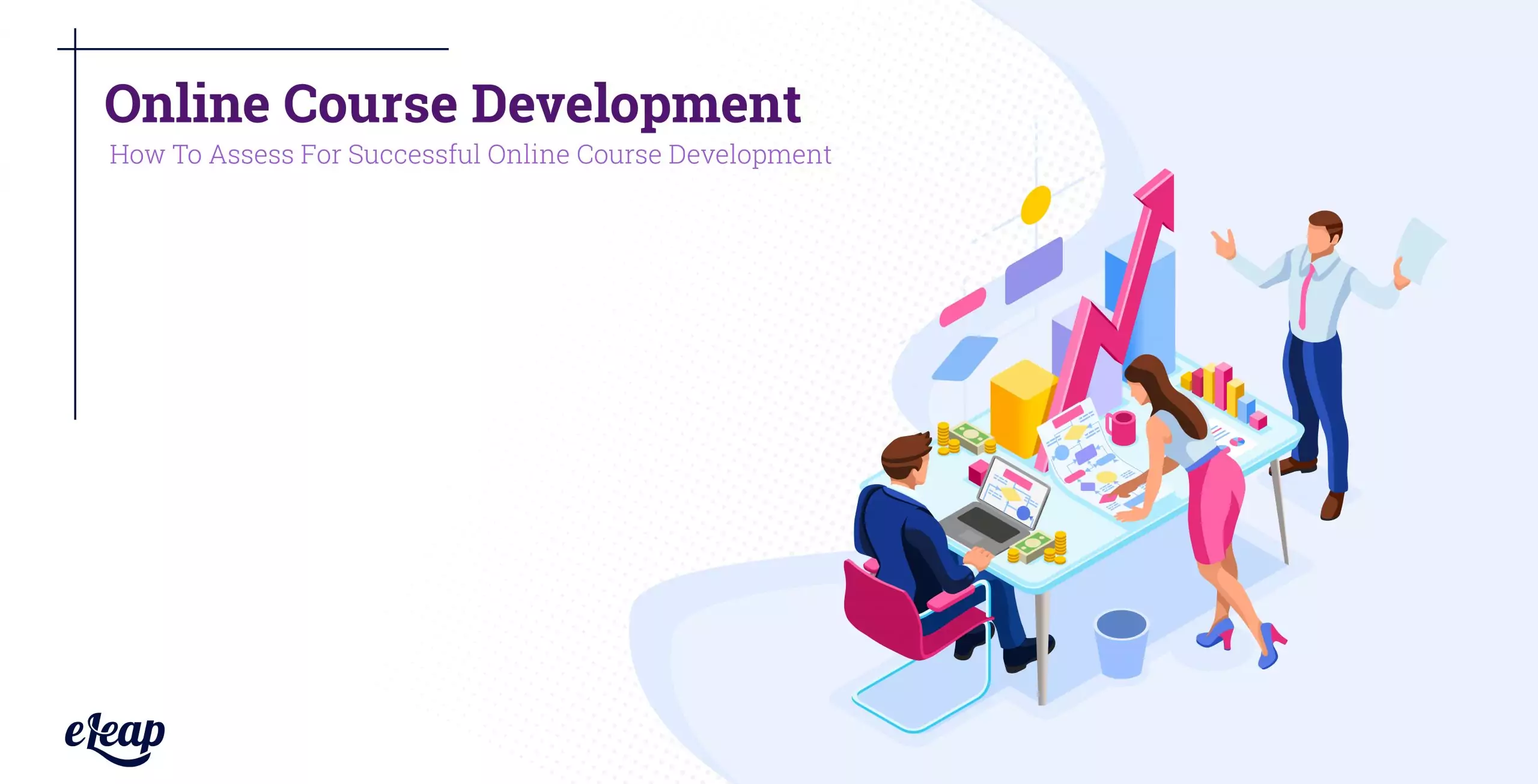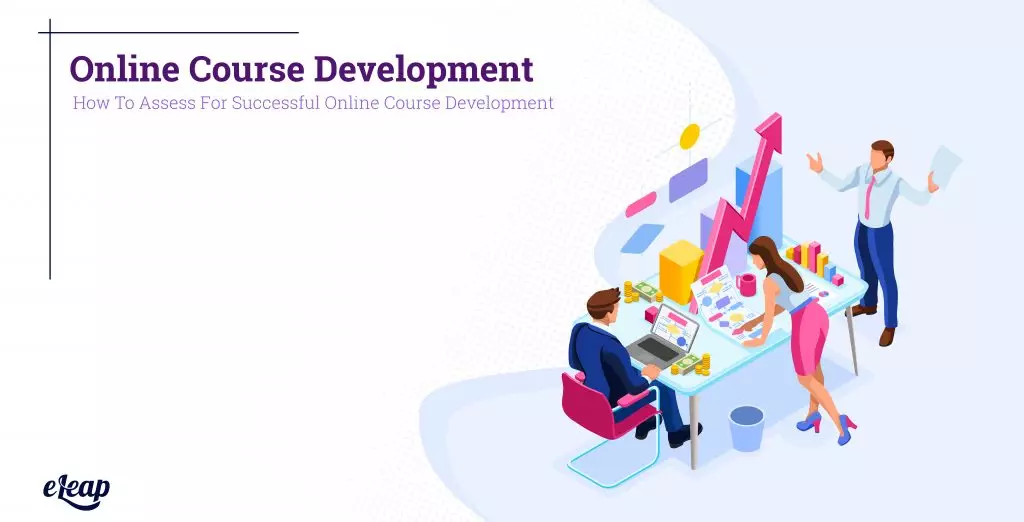Online Course Development
How To Assess For Successful Online Course Development

While there are many tools for online course development, tools like Articulate 360, or Camtasia, Adobe Captivate, when it comes down to it, how do you know your efforts are succeeding? Your employees and students want to have fruitful growth in your organization. You use eLearning and other online educational resources to give them more opportunities to learn and flourish.
But how can you determine if online course development is truly successful? Is your online learning platform pushing forward your L&D strategy?
Assessing Online Course Development
In order to understand your online course’s success, you need to test it. Giving your employees an assessment has a twofold purpose: you are not only evaluating the knowledge they gained from the course but also you are appraising the value of the course overall.
Which kinds of assessments should you use for a thorough evaluation?

Summative Assessment vs Formative Assessment
There are two types of tests. Summative assessments “sum up” everything that the individual has learned in the course. These are usually administered at the end of the entire course and present the learner with a grade or scale so they can see how well they did. This helps the employee place himself or herself in a general idea of success: how far did I grow from the beginning of the course? how will I use this knowledge to continue to grow in my position?
Formative assessments are usually given as the course is still active, similar to pop quizzes or chapter exams. These are useful to help identify areas that need improvement before the course ends: where do I need to go back and review in order to meet the learning objectives of the course? what do I need to work on moving forward in order to be successful by the end of the course?
Both the summative and formative assessments also help pinpoint strengths and weaknesses of the course itself, which will be discussed below.
Using Varied Tests
People have different learning styles, which also means they have different testing styles. Some people absorb and relay information in different ways than others. Some prefer to take a bubble test while others prefer to create a presentation teaching what they learned. In this way, it’s important to use a variety of tests in your assessments. Furthermore, a blend of evaluation types can also reflect the material of the exam; some skillsets or knowledge are more appropriately utilized through given assessment tool.
This includes mixing formative with summative as well as blending multiple choice, true/false, essays, interactive, presentation creation, and even on-the-job assessments.
Using A Reward System
Many managers ask the question: should you use a reward system with regards to assessment? The answer is yes and no.
You want to reward people who show that they have taken the knowledge from the course and applied it to the work. You also want to reward those people who voluntarily spread the knowledge from the course with others in an effort to progress the entire team as one.
However, you don’t want to reward or punish based on grades or tests. This can be discouraging or feel “false.”
If someone does really poorly on a course, don’t punish them for it. Maybe they just don’t test well. Instead, think about a new way of learning for them. Have them sit down with HR or their manager for a conversation about how they can further evolve and grow.
Boosting Online Course Development
Assessing your online course tells you where your course stands—but how can you make your course even better? What should you be doing in order to ensure a strong online course development for your employees moving forward?
- Define learning objectives.
Before you even put a course on the library log, you need to figure out how that course will fit in with your overall L&D strategy. What are the learning objectives or goals that will push forward that online course development?
Clearly, define these learning objectives for the students of the course. Let them know exactly what and how they will be learning. This boosts engagement with the material simply because they are prepared for it. Setting defined learning objectives will tell your employees:
- what information is most relevant (hierarchy of info for retention).
- how they can measure their own success in the course.
- how they will be able to apply this information to their jobs.
- why the course is important to them.
From there, you should then create assessments that are aligned with these learning objectives. It is only by clearly expressing the goals of the course to understand what “success” looks like on an assessment. Always ensure that your students know the learning objectives and relevant grading rubric in advance. If they feel it was a “surprise,” they will feel unmotivated and discouraged to continue to learn. This isn’t about stressing them out or wanting them to fail; this is about preparing them so they can learn and grow in tandem with your online course development strategy.
- Focus on assessments with the application.
Managers often make the mistake of believing that test success equates to on-the-job performance. A test should be more than just what they can remember and recall from the course. Instead, evaluations should look at how well employees are able to apply that proficiency in the workplace.
This comes by setting learning objectives that are aligned with the role or position of the individual. Not everyone will have the same learning objectives because not everyone learns the same way and not everyone has the same role within the company.
How will the assessed learning objectives apply practically?
If the application is not at the crux of your testing, you will stagnate any future online course development and growth.
- Identify trends of strengths and weaknesses.
While you’re using assessment to see the success of a given individual, you can also use these evaluations to see where you need to further improve your online course development.
Look at the data in its entirety. Where are people doing well? Where are the weak areas? For example, if a vast majority of the accounting team did well on “Economics 101,” you would assume that was a great course. But a majority of the marketing team did poorly on “Economics 101.” This likely means the course is geared more towards those with an economics background previously, so maybe it isn’t a basic 101 course. You may need to look into more basic or comprehensive courses for future marketing team training to ensure they fully grasp all the learning.
Using a mixture of summative and formative assessments will help you identify these areas of strength or weaknesses. Summative assessments can show the overall success of the course. Who did well? What did they learn? Did a majority do well or poorly? This is crucial to understanding how to boost online course development in terms of the relationship between defined learning objectives and tested results.
Formative evaluations pinpoint exactly which areas of the course are most challenging or rewarding for employees. Although the summative can show overall success, formative evaluations are more defined pieces of information that can help identify key trends and patterns within a given course.
- Respond with an in-depth analysis.
Gather the data up and write about it for both the employees and for the HR team.
Give quality feedback to employees—more than just grades. Where can they improve? What are they doing well? How are they doing in comparison to their peers? How can they apply these results to their job or role? How should they use this knowledge going forward?
An in-depth analysis of the data also determines the future of the online course development in the L&D department. How are people growing through these online resources? What can be improved to better these courses moving forward? A comprehensive analysis is a great tool for determining future strategy.
The Bottom Line
How well are your employees doing? How well are your courses succeeding at meeting key learning objectives? The best way to you’re your employees is to continuously better the resources available to them. Assessments are about both employee growth as well as online course development.
Conclusion: say something about how you are assessing for both employee development and online course development – the best way to help your employees is to continuously better your resources for them